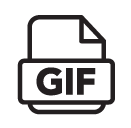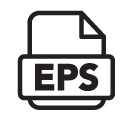Have you ever wondered when you should use a JPG instead of a PNG? Unless you’re a graphic designer by training, chances are you’ve never needed to understand things like what separates a TIF from a PDF or a PNG from a JPG. While the large variety of image formats may seem overwhelming, there is a method to the madness. Hopefully this guide can provide a better understanding of the standard file types and which are most appropriate for your project.
1. EPS FORMAT (vector)
The EPS (pronounced ee-pee-ess) of your logo is what’s known as a source file – a file from which ALL other types and formats can be made. This is a vector-based file, which in the simplest terms means that it features unlimited resolution – it can be reproduced at any size without any degradation of sharpness or quality. The artwork in this file can be edited with little difficulty (but it DOES require specific software and someone who knows what they’re doing to do so.) This is the file that you will send to almost anybody who is going to print something for you, be it T-shirts, brochures or mugs. Can be imported into many other design applications. You probably won’t use this file too much (unless you have access to design software like Adobe Illustrator or if the software you’re using requests an EPS file) but keep it safe and make backups. As long as you have this file you can start over if disaster – a hard drive failure for example – strikes.
2. PDF FORMAT (vector)
The main advantage of a PDF (pee-dee-eff) file is that you can view a high-resolution vector-based version of your logo without having access to professional design software. Most internet browsers have built-in features that open PDF files, as do most smart phones and tablets. A designer can, in a crunch, also use this as a source file for your logo (but requires professional design software.) In fact, many designers will forgo both EPS and AI files completely, delivering only a PDF to clients. Like EPS and AI files, it is generally vector based and likewise features unlimited resolution.
3. JPG FORMAT (pixel)
A JPG (jay-peg) file is made up from pixels as it’s main function is use on electronic screens such as part of a website, social media avatar, email signature and the like. It is generally fairly color accurate (some colors like red and orange can tend to clump up due to image compression.) The main thing to note about a JPG file is that transparency is NOT an option and it ALWAYS has a background bounding box. IF you want an image with a transparent background (you can see through it) use a PNG instead. Universally supported by every browser and social media platform, so as long as you don’t want that transparent background, a JPG will suffice for electronic use. Usually in an RGB (Red, Green & Blue) color system for TVs and monitors, so colors may shift badly if used in print. As this is a pixel based format, original size cannot be enlarged without image pixelation and can only be used at 100% size or less.
4. PNG FORMAT (pixel)
A PNG (pee-en-gee) file is also pixel based and used where the end goal is to be viewed on a monitor – on a website, email signature or the like. While a PNG can be a larger file size to a JPG (thus slower to download) It has several main advantages, the most notable is that it can feature a transparent (clear) background. Depending on the “bit” level of your PNG file, this format is “lossless” – there is no image degradation (gradients or blended colors may show banding with lower bit rates.) Also supports opacity (when your logo appears ghosted with some details below it showing through.) While there are still a few applications and platforms that don’t fully support PNGs’ transparency function, this is practically the universal standard for high-quality logo images.





Quick Tips:
Changing the extension in a file name by typing in another will NOT change the file format OF the file. You should never do this anyway.
An EPS file of your logo can be imported into other design software. It is unlimited resolution and can be enlarged without image degradation. Can be edited (with appropriate software & technical knowledge) and used as a source file for other file types. Primarily a print file and NOT for use on web. You can make bitmap or pixel images from a vector file, but usually not vice versa.
JPG files are primarily for use on monitors and TVs. Used extensively on most web based platforms and applications. Can be compressed to lower file size (and speed up download over the internet) but some image degradation may be apparent. Cannot be used larger than 100% of original image size. ALWAYS features a background color. Difficult to edit.
PNG format can feature a transparent (clear) background. Great color accuracy (though blends or gradients may “band” with lower bit rate files.) Cannot be used larger than 100% of original image size though reduces well. Considered universal standard for pristine logo presentation on websites and electronic media, though not fully supported by some platforms (those that don’t usually convert PNGs to JPGs.) Difficult to edit.
OTHER FORMATS
JPEG (or JPG) – Joint Photographic Experts Group
PNG – Portable Network Graphics
GIF – Graphics Interchange Format
TIFF – Tagged Image File
PSD – Photoshop Document
PDF – Portable Document Format
EPS – Encapsulated Postscript
AI – Adobe Illustrator Document
INDD – Adobe Indesign Document
RAW – Raw Image Formats


